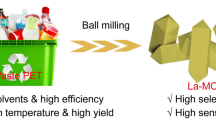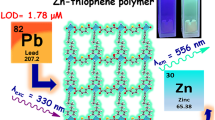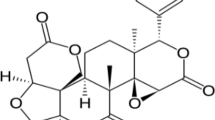Abstract
This paper describes initially the application of the Tyndall effect (TE) of metal–organic framework (MOF) materials as a colorimetric signaling strategy for the sensitive detection of pyrophosphate ion (PPi). The used MOF NH2-MIL-101(Fe) was prepared with Fe3+ ions and fluorescent ligands of 2-amino terephthalic acid (NH2-BDC). The fluorescence of NH2-BDC in MOF is quenched due to the ligand-to-metal charge transfer effect, while the NH2-MIL-101(Fe) suspension shows a strong TE. In the presence of PPi analyte, the MOFs will undergo decomposition because of the competitive binding of Fe3+ by PPi over NH2-BDC, resulting in a significant decrease in the TE signal and fluorescence restoration from the released ligands. The results demonstrate that the new method only requires a laser pointer pen (for TE creation) and a smartphone (for portable quantitative readout) to detect PPi in a linear concentration range of 1.25–800 μM, with a detection limit of ~210 nM (3σ) which is ~38 times lower than that obtained from traditional fluorescence with a spectrophotometer (linear concentration range, 50–800 µM; detection limit, 8.15 µM). Moreover, the acceptable recovery of PPi in several real samples (i.e., pond water, black tea, and human serum and urine) ranges from 97.66 to 119.15%.
Graphical Abstract





Similar content being viewed by others
References
Stetten MR. Metabolism of inorganic pyrophosphate. J Biol Chem. 1964;239:3576–83. https://doi.org/10.1016/s0021-9258(18)97761-6.
Lee S, Yuen KK, Jolliffe KA, Yoon J. Fluorescent and colorimetric chemosensors for pyrophosphate. Chem Soc Rev. 2015;44:1749–62. https://doi.org/10.1039/c4cs00353e.
Chen CY, Tan YZ, Hsieh PH, Wang CM, Shibata H, Maejima K, et al. Metal-free colorimetric detection of pyrophosphate ions by inhibitive nanozymatic carbon dots. ACS Sens. 2020;5:1314–24. https://doi.org/10.1021/acssensors.9b02486.
Dong C, Ma X, Qiu N, Zhang Y, Wu A. An ultra-sensitive colorimetric sensor based on smartphone for pyrophosphate determination. Sens Actuators B: Chem. 2021;329:129066. https://doi.org/10.1016/j.snb.2020.129066.
Anbu S, Paul A, Stasiuk GJ, Pombeiro AJL. Recent developments in molecular sensor designs for inorganic pyrophosphate detection and biological imaging. Coordin Chem. 2021;431:213744. https://doi.org/10.1016/j.ccr.2020.213744.
Kim S, Han J, Chung H, Choi YK, Hashkavayi AB, Zhou Y, et al. Pyrophosphate-enhanced oxidase activity of cerium oxide nanoparticles for colorimetric detection of nucleic acids. Sensors. 2021;21:7567. https://doi.org/10.3390/s21227567.
Xu SQ, He M, Yu HP, Wang XY, Tan XL, Lu B, et al. Bioluminescent method for detecting telomerase activity. Clin Chem. 2002;48:1016–20. https://doi.org/10.1093/clinchem/48.7.1016.
Cowart RE, Swope S, Loh TT, Chasteen ND, Bates GW. The exchange of Fe3+ between pyrophosphate and transferrin. Probing the nature of an intermediate complex with stopped flow kinetics, rapid multimixing, and electron paramagnetic resonance spectroscopy. J Biol Chem. 1986;261:4607–14. https://doi.org/10.1016/s0021-9258(17)38545-9.
Greenfield TJ, Julve M, Doyle RP. Exploring the biological, catalytic, and magnetic properties of transition metal coordination complexes incorporating pyrophosphate. Coordin Chem. 2019;384:37–64. https://doi.org/10.1016/j.ccr.2018.12.011.
Tsui FWL. Genetics and mechanisms of crystal deposition in calcium pyrophosphate deposition disease. Curr Rheumatol Rep. 2011;14:155–60. https://doi.org/10.1007/s11926-011-0230-6.
Nonaka A, Horie S, James TD, Kubo Y. Pyrophosphate-induced reorganization of a reporter–receptor assembly via boronate esterification; a new strategy for the turn-on fluorescent detection of multi-phosphates in aqueous solution. Org Biomol Chem. 2008;6:3621–5. https://doi.org/10.1039/b808027e.
Yang Y, Chen P, Liu Y, Cai Z, Wang X, Me Y, et al. A colorimetric indicator-displacement assay based on stable Cu2+ selective carbon dots for fluorescence turn-on detection of pyrophosphate anions in urine. Spectrochim Acta A. 2021;251:119479. https://doi.org/10.1016/j.saa.2021.119479.
Harrington CT, Lin EI, Olson MT, Eshleman JR. Fundamentals of pyrosequencing. Arch Pathol Lab. 2013;137:1296–303. https://doi.org/10.5858/arpa.2012-0463-RA.
Wongkongkatep J, Ojida A, Hamachi I. Fluorescence sensing of inorganic phosphate and pyrophosphate using small molecular sensors and their applications. Topics Curr Chem. 2017;375:30. https://doi.org/10.1007/s41061-017-0120-0.
An X, Tan Q, Pan S, Liu H, Hu X. A turn-on luminescence probe based on amino-functionalized metal-organic frameworks for the selective detections of Cu2+, Pb2+ and pyrophosphate. Spectrochim Acta A. 2021;247:119073. https://doi.org/10.1016/j.saa.2020.119073.
Lanne ABM, Goode A, Prattley C, Kumari D, Drasbek MR, Williams P, et al. Molecular recognition of lipopolysaccharide by the lantibiotic nisin. BBA-Biomembranes. 2019;1861:83–92. https://doi.org/10.1016/j.bbamem.2018.10.006.
Yu Q, Peng Y, Cao Q, Ma J, Shi Z, Jia Q. Pyridinaldehyde modified luminescence metal-organic framework for highly sensitive and selective fluorescence detection of pyrophosphate. Sens Actuators B: Chem. 2022;365:131949. https://doi.org/10.1016/j.snb.2022.131949.
Jin H, Chen J, Zhang J, Sheng L. Impact of phosphates on heat-induced egg white gel properties: texture, water state, micro-rheology and microstructure. Food Hydrocolloids. 2021;110:106200. https://doi.org/10.1016/j.foodhyd.2020.106200.
Lin Z, Luo S, Xu D, Liu S, Wu N, Yao W, et al. Silica-polydopamine hybrids as light-induced oxidase mimics for colorimetric detection of pyrophosphate. The Analyst. 2020;145:424–33. https://doi.org/10.1039/c9an01813a.
Xu H, Zhu X, Dong Y, Wu H, Chen Y, Chi Y. Highly sensitive electrochemiluminescent sensing platform based on graphite carbon nitride nanosheets for detection of pyrophosphate ion in the synovial fluid. Sens Actuators B: Chem. 2016;236:8–15. https://doi.org/10.1016/j.snb.2016.05.056.
Sronsri C, Sittipol W, U-yen K. Optimization of biodiesel production using magnesium pyrophosphate. Chem Eng Sci. 2020;226:115884. https://doi.org/10.1016/j.ces.2020.115884.
Ito M, Fujii N, Wittwer C, Sasaki A, Tanaka M, Bittner T, et al. Hydrophilic interaction liquid chromatography–tandem mass spectrometry for the quantitative analysis of mammalian-derived inositol poly/pyrophosphates. J Chromatogr A. 2018;1573:87–97. https://doi.org/10.1016/j.chroma.2018.08.061.
Nguyen VL, Darman M, Ireland A, Fitzpatrick M. A high performance liquid chromatography fluorescence method for the analysis of both pyridoxal-5-phosphate and thiamine pyrophosphate in whole blood. Clin Chim Acta. 2020;506:129–34. https://doi.org/10.1016/j.cca.2020.03.026.
Li F, Liu Y, Li Z, Li Q, Liu X, Cui H. Cu(II)-regulated on-site assembly of highly chemiluminescent multifunctionalized carbon nanotubes for inorganic pyrophosphatase activity determination. ACS Appl Mater Interfaces. 2020;12:2903–9. https://doi.org/10.1021/acsami.9b20259.
Xu W, Shao C, Pang J, Jiang Y, Han Y, Wang J. Electrochemical method of pyrophosphate determination by quinone reduction. Electrochim Acta. 2019;300:171–6. https://doi.org/10.1016/j.electacta.2019.01.096.
Xu HR, Li K, Jiao SY, Li LL, Pan SL, Yu XQ. Tetraphenylethene based zinc complexes as fluorescent chemosensors for pyrophosphate sensing. Chinese Chem Lett. 2015;26:877–80. https://doi.org/10.1016/j.cclet.2015.05.037.
Wang ZX, Yu XH, Li F, Kong FY, Lv W-X, Fan DH, et al. Preparation of boron-doped carbon dots for fluorometric determination of Pb(II), Cu(II) and pyrophosphate ions. Microchim Acta. 2017;184:4775–83. https://doi.org/10.1007/s00604-017-2526-3.
Li N, Zhu YD, Liu T, Liu SG, Lin SM, Shi Y, et al. Turn-on fluorescence detection of pyrophosphate anion based on DNA-attached cobalt oxyhydroxide. New J Chem. 2017;41:1993–6. https://doi.org/10.1039/c6nj03491h.
Zhu W, Huang X, Guo Z, Wu X, Yu H, Tian H. A novel NIR fluorescent turn-on sensor for the detection of pyrophosphate anion in complete water system. Chem Commun. 2012;48:1784–6. https://doi.org/10.1039/c2cc16902a.
Selva Sharma A, Suresh Nair S, Varghese AW, Usha A, Varghese RE, Joseph R, et al. Dual-emissive carbon dots: exploring their fluorescence properties for sensitive turn-off-on recognition of ferric and pyrophosphate ions and its application in fluorometric detection of the loop-mediated isothermal amplification reaction. Langmuir. 2023;39:5779–92. https://doi.org/10.1021/acs.langmuir.3c00041.
Zhang WJ, Liu SG, Han L, Luo HQ, Li NB. A ratiometric fluorescent and colorimetric dual-signal sensing platform based on N-doped carbon dots for selective and sensitive detection of copper(II) and pyrophosphate ion. Sens Actuators B: Chem. 2019;283:215–21. https://doi.org/10.1016/j.snb.2018.12.012.
Das A, De S, Das G. Naphthyl-functionalized ninhydrin-derived receptor for ‘CHEF’-based sequential sensing of Al(III) and PPi: prospective chemosensing applications under physiological conditions. J Photoch Photobio A. 2021;418:113422. https://doi.org/10.1016/j.jphotochem.2021.113442.
Dai Y, Liu Z, Bai Y, Chen Z, Qin J, Feng F. A novel highly fluorescent S, N, O co-doped carbon dots for biosensing and bioimaging of copper ions in live cells. RSC Adv. 2018;8:42246–52. https://doi.org/10.1039/c8ra09298b.
Kong C, Liu Q, Li W, Chen Z. Single particle-based colorimetric assay of pyrophosphate ions and pyrophosphatase with dark-field microscope. Sens Actuators B: Chem. 2019;299:126999. https://doi.org/10.1016/j.snb.2019.126999.
Shi D, Sun Y, Lin L, Shi C, Wang G, Zhang X. Naked-eye sensitive detection of alkaline phosphatase (ALP) and pyrophosphate (PPi) based on a horseradish peroxidase catalytic colorimetric system with Cu(II). Analyst. 2016;141:5549–54. https://doi.org/10.1039/c6an01124a.
Tian X, Qi W, Zhao M, Lai J, Wu D, Hu L, et al. One-pot synthesis of luminol–gallium nanoassemblies and their peroxidase-mimetic activity for colorimetric detection of pyrophosphate. New J Chem. 2020;44:21176–82. https://doi.org/10.1039/d0nj02628j.
Inoue K, Aikawa S, Fukushima Y. Colorimetric detection of pyrophosphate in aqueous solution by pyrogallol red-based Zn2+ complex in the presence of poly(diallyldimethylammonium chloride). Polym Bull. 2018;76:1641–9. https://doi.org/10.1007/s00289-018-2461-4.
Zhang S, Qiao M, Liu T, Ding L, Fang Y. Construction of naphthalimide-based fluorescent amphiphilic aggregates and sensitive detection of persulfate and pyrophosphate anions. Sens Actuators B: Chem. 2022;365:131931. https://doi.org/10.1016/j.snb.2022.131931.
Luo L, Chen Y, Zhang L, Li Y, Li H, Zhang H, et al. SERS assay for pyrophosphate based on its competitive binding to Cu(II) ion on silver nanoparticles modified with cysteine and rhodamine 6G. Microchim Acta. 2016;184:595–601. https://doi.org/10.1007/s00604-016-2044-8.
Cao HT, Zhao T, Liu MQ, Guo LZ, He YQ, Zhang K, et al. Ratiometric optical detection of pyrophosphate based on aggregation-caused dual-signal response of gold nanoclusters. Luminescence. 2023;38:1458–64. https://doi.org/10.1002/bio.4527.
Jin L, Zhao C, Wang X, Zhang Q, Jiang Y, Shen J. Metal-free auxiliary pyrophosphate detection based on near-infrared carbon dots. Spectrochim Acta A. 2023;295:122580. https://doi.org/10.1016/j.saa.2023.122580.
Gao Y, Jiao Y, Zhang H, Lu W, Liu Y, Han H, et al. One-step synthesis of a dual-emitting carbon dot-based ratiometric fluorescent probe for the visual assay of Pb2+ and PPi and development of a paper sensor. J Mater Chem B. 2019;7:5502–9. https://doi.org/10.1039/c9tb01203f.
Hou L, Huang Y, Lin T, Ye F, Zhao S. A FRET ratiometric fluorescence biosensor for the selective determination of pyrophosphate ion and pyrophosphatase activity based on difunctional Cu-MOF nanozyme. Biosens Bioelectron. 2022;10:100101. https://doi.org/10.1016/j.biosx.2021.100101.
Li H, Ren J, Xu X, Ning L, Tong R, Song Y, et al. A dual-responsive luminescent metal-organic framework as a recyclable luminescent probe for the highly effective detection of pyrophosphate and nitrofurantoin. Analyst. 2019;144:4513–9. https://doi.org/10.1039/c9an00718k.
Helal A, Arafat ME, Rahman MM. Pyridinyl conjugate of UiO-66-NH2 as chemosensor for the sequential detection of iron and pyrophosphate ion in aqueous media. Chemosensors. 2020;8:122. https://doi.org/10.3390/chemosensors8040122.
Yu H, Long D. Highly chemiluminescent metal-organic framework of type MIL-101(Cr) for detection of hydrogen peroxide and pyrophosphate ions. Microchim Acta. 2016;183:3151–7. https://doi.org/10.1007/s00604-016-1963-8.
Ma J, Wang S, Wang T, Ma J, Wang Z. Ratiometric fluorescence assay for pyrophosphate based on sulfur nanodots decorated metal-organic frameworks. Chemistry. 2023;29:e202300366. https://doi.org/10.1002/chem.202300366.
Xiao W, Deng Z, Huang J, Huang Z, Zhuang M, Yuan Y, et al. Highly sensitive colorimetric detection of a variety of analytes via the Tyndall effect. Anal Chem. 2019;91:15114–22. https://doi.org/10.1021/acs.analchem.9b03824.
Huang J, Mo X, Fu H, Sun Y, Gao Q, Chen X, et al. Tyndall-effect-enhanced supersensitive naked-eye determination of mercury (II) ions with silver nanoparticles. Sens Actuators B: Chem. 2021;344:130218. https://doi.org/10.1016/j.snb.2021.130218.
Zorainy MY, Gar Alalm M, Kaliaguine S, Boffito DC. Revisiting the MIL-101 metal-organic framework: design, synthesis, modifications, advances, and recent applications. J Mater Chem A. 2021;9:22159–217. https://doi.org/10.1039/d1ta06238g.
Li S, Hu X, Chen Q, Zhang X, Chai H, Huang Y. Introducing bifunctional metal-organic frameworks to the construction of a novel ratiometric fluorescence sensor for screening acid phosphatase activity. Biosens Bioelectron. 2019;137:133–9. https://doi.org/10.1016/j.bios.2019.05.010.
Hu H, Zhang H, Chen Y, Ou H. Enhanced photocatalysis using metal-organic framework MIL-101(Fe) for organophosphate degradation in water. Environ Sci Pollut R. 2019;26:24720–32. https://doi.org/10.1007/s11356-019-05649-2.
Wang X, Yun Y, Sun W, Lu Z, Tao X. A high-performance fluorescence immunoassay based on pyrophosphate-induced MOFs NH2-MIL-88B(Fe) hydrolysis for chloramphenicol detection. Sens Actuators B: Chem. 2022;353:1131143. https://doi.org/10.1016/j.snb.2021.131143.
Xie D, Ma Y, Gu Y, Zhou H, Zhang H, Wang G, et al. Bifunctional NH2-MIL-88(Fe) metal-organic framework nanooctahedra for highly sensitive detection and efficient removal of arsenate in aqueous media. J Mater Chem A. 2017;5:23794–804. https://doi.org/10.1039/c7ta07934f.
Acknowledgements
This work was financially supported by the Central Government-Guided Local Science and Technology Development Project (No. GuikeZY20198006), the Guangxi Scholarship Fund of Guangxi Education Department (No. Guijiaoren-2019-5), the National Natural Science Foundation of China (Nos. 21874032 and 21765007), and the Guangxi Science Fund for Distinguished Young Scholars (No. 2018GXNSFFA281002).
Author information
Authors and Affiliations
Corresponding authors
Ethics declarations
Ethics approval and consent to participate
All the human serum and urine samples in this study were collected from the Affiliated Hospital of Guilin University of Technology with a protocol approved by the Review Board and Ethical Committee of Guilin University of Technology.
Conflict of interest
The authors declare no competing interests.
Additional information
Publisher's Note
Springer Nature remains neutral with regard to jurisdictional claims in published maps and institutional affiliations.
Supplementary Information
Below is the link to the electronic supplementary material.
Rights and permissions
Springer Nature or its licensor (e.g. a society or other partner) holds exclusive rights to this article under a publishing agreement with the author(s) or other rightsholder(s); author self-archiving of the accepted manuscript version of this article is solely governed by the terms of such publishing agreement and applicable law.
About this article
Cite this article
Huang, X., Yan, Y., Zhang, L. et al. Simple, sensitive, colorimetric detection of pyrophosphate via the analyte-triggered decomposition of metal–organic frameworks regulating their adaptive multi-color Tyndall effect. Anal Bioanal Chem 416, 1821–1832 (2024). https://doi.org/10.1007/s00216-024-05200-4
Received:
Revised:
Accepted:
Published:
Issue Date:
DOI: https://doi.org/10.1007/s00216-024-05200-4




